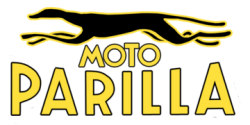

Frames for high-cam went through several changes since the motor was introduced in 1953. The first generation frames looked complicated and labor intensive to make. The frames for late 50's bikes were more streamlined and simpler. The only exception was the GS frames that still had some custom modifications. Sometime around 1958 ('59?), a new frame type was put into production. This frame was more angular, slightly shorter, and had more stamped metal brackets welded on. The frame for 250 Wildcat frame was designed separate from other models to handle the brutal off-road racing environment. Here are a few examples of various high-cam frames constructed by the factory.
First generation 1953-54
|
|
|
|
The first high-cams used this rather busy, bracket festooned, cradle frame for the first couple of years. This frame was similar to the other early 50's Parilla frames (Twin, 125, etc) where everything was built take more punishing, undeveloped roads. This frame is much heavier (using cast iron lugs) than later designs.
Second generation 1955-59
|
|
|
|
|
|
|
|
|
This frame was a streamline version of the early frame reduced to the basics. The motor now became part of the frame. Two slightly different versions of the frame were used for GS, Speedster and 175 Wildcats. The GS model had an extended rear bracket that tapered back to hold up the rear fender, while the Speedster/Wildcat version was 6 inches shorter. The GS frame also had a custom welded rear engine mount and brackets for the rear sets, while the Speedster/Wildcat used a stamped metal bracket to do the job. The Wildcat used the same frame as the Speedster, but the only differences were that the passenger footpegs were capped off and a 501-xxx serial number was used rather than the 406, 407-xxx numbers for the Speedster.
Third generation 1958-63+
|
|
|
|
|
|
This was a completely different type of frame than those of the mid-late 50's. More angular and slightly more compact, this type of frame was use on all Parillas (except the 250 Wildcat) until the factory closed. The 125 frames had different engine mounts added while the very first years of the design had a shorter rear bracket for the shocks and rear fender. In racing circles, this frame was considered slightly more unstable for racing than the previous design and racer used a longer swingarm to fix the problem.
125cc/250cc Frames
|
|
|
|
The 125 bikes share the same frame as the 250 models. The only modifications are the motor brackets and some of the wiring being routed inside the front downtube.
250 Wildcat frame
A very robust frame design was used for the 250 Wildcat with extra bracing for off road competition. There was also a factory race bike version of this frame with even more support. According to a magazine report in 1964, Cosmo's Ernest Wise visited the factory to oversee the production of a 5 speed Grand Sport road racer.
|
|
|
|
||
|
Wildcat frame |
1964 Wildcat frame racer |